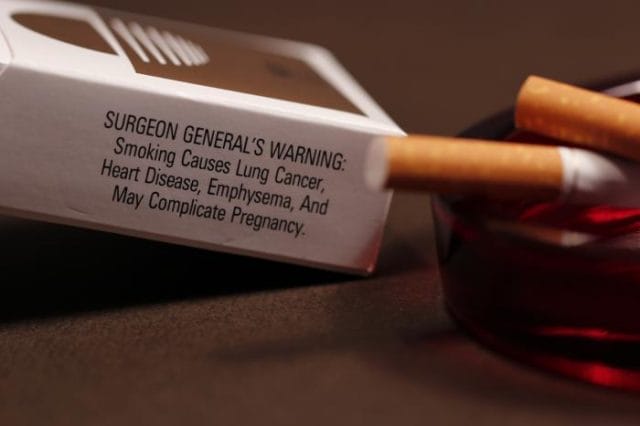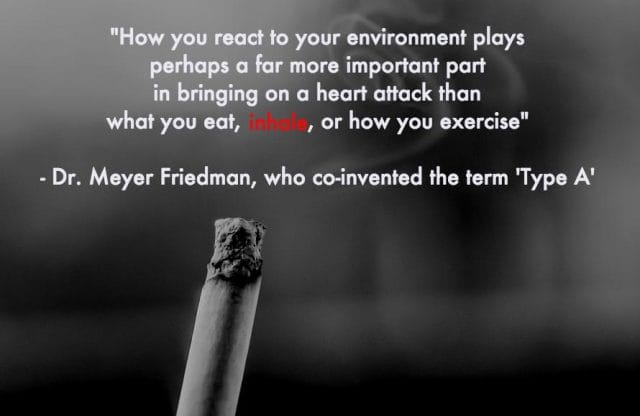
You create to-do lists that end with “write a new to-do list.” You make a resolution every New Year, and you always succeed. You only enter competitions that you intend to win. You relish the stress of an impending deadline.
You are—in other words—Type A: an ambitious, goal-oriented, and competitive person. You know it, and you may even feel proud of that distinction.
But if you knew the origins of the term, you might feel differently about being Type A.
The two men who coined the term ‘Type A’ in the 1960s were also goal-oriented, high achieving types. But they wanted to be Type B: easygoing, take every day as it comes type people. Because while many people now use the term Type A as a badge of honor, the two men were cardiologists, and they invented the term Type A to describe stressed patients who were at a higher risk of heart attack, stroke, and other cardiovascular conditions.
So why did this medical term become a cultural mainstay? One reason is that the idea proved very influential—the two cardiologists wrote a bestselling book about Type A behavior and their work guided future medical research.
The other reason is that the cardiologists and their peers had very generous patrons who funded their research and promoted their ideas: the executives of tobacco companies, who desperately wanted to pin the blame for the high rates of heart attack and cardiovascular disease among their customers on something other than smoking.
The Coining of a Term
Sixty years ago, a secretary in the office of a private medical practice in San Francisco made a fateful observation.
The patients who had coronary heart disease, she told several of the doctors, never sat down on the waiting room’s sofas. These patients, who were at risk for heart attacks, always sat in the hard chairs, and unlike the other patients, they arrived on time.
That is how Dr. Ray Rosenman, who died in 2013, told the story of his and Dr. Meyer Friedman’s famous medical finding. At the time, in the 1950s, the two cardiologists were conducting research that led them to doubt existing explanations for the buildup of cholesterol in heart attack and coronary disease patients. As they considered alternative explanations, the secretary pointed out that all their coronary patients were irritable men who fidgeted, checked their watch, and jumped out of their chairs to demand to know when their appointment would start.
The observation led to a paper, in 1959, that explored the association between a “specific overt behavior pattern” and coronary disease. Rosenman and Friedman defined this “overt behavior pattern A” as:
1) an intense, sustained drive to achieve self-selected but usually poorly defined goals
2) profound inclination and eagerness to compete
3) persistent desire for recognition and advancement
4) continuous involvement in multiple and diverse functions constantly subject to time restrictions (deadlines)
5) habitual propensity to accelerate the rate of execution of many physical and mental functions
6) extraordinary mental and physical alertness.
In other words, the cardiologists argued that harried, goal-oriented people got heart attacks. Two years later, at the urging of a public health director, they slimmed down their terminology from “overt behavior pattern A” and “overt behavior pattern B” to Type A and Type B.
Today, doctors and researchers describe Friedman and Rosenman as “pioneers” and “figures of major importance”. But in the 1960s, their idea faced pushback.
Friedman and Rosenman were not the first researchers to suggest that our thoughts and behavior can make us sick. More than two decades earlier, Dr. Hans Selye began the investigations that earned him the moniker “the father of stress”: Selye stressed out rats with painful injections and extremely hot and cold temperatures, cut into the rats’ organs, and revealed the damage stress wrought on the body.
Yet cardiologists in particular thought of their work as engineering—not psychiatry. “Cardiologists hated these guys,” Stanford neuroendocrinologist Robert Sapolsky has said. Doctors who thought about heart disease patients like fixing a machine, he adds, resisted the idea that they needed to talk to patients (“Christ! Talk to the patient?”) and ask if they got angry when the supermarket checkout line moved slowly.
What made Friedman and Rosenman’s work compelling in this hostile environment, according to Dr. Karen Matthews of the University of Pittsburgh, were their novel methods. Researchers had started looking at how “psychosocial characteristics” like stress could be risk factors. But, Matthews says, “there was little systematic data.” In this context, Friedman and Rosenman’s approach—they recruited subjects who exhibited Type A or Type B behavior and showed that coronary artery disease symptoms were seven times more frequent in the Type As—was trailblazing.
Type A went from medical terminology to part of popular culture when Friedman and Rosenman published a book titled Type A Behavior and Your Heart. As a reviewer noted at the time, the cardiologists seemed to only confirm what a nation of anxious strivers already suspected: “Those who step back and see us killing ourselves to get ahead should not be surprised at a more palpable documentation of that reality.”
In 1975, the book appeared on the New York Times bestseller list alongside Jaws and Watership Down. The book quickly made Type A a popular phrase—a fact aided by Friedman’s salesmanship. “Dr. Friedman…was fond of observing acquaintances at cocktail parties,” an obituary commented in 2001, and warning them, ‘Watch out, take it easy, you’re a real Type A!’”
Part of the book’s appeal was likely this self-help nature. While people today tend to think of Type A and Type B as inherent personalities, Friedman disliked that people used the phrase “Type A personality.” He preferred the term “Type A behavior,” and he described himself as a “recovering Type A” the same way self-help experts describe their troubled past lives.
When Type A Behavior and Your Heart was published, reviewers and prominent doctors described Type A behavior as an important but unproven idea.
Luckily the two cardiologists found a wealthy supporter to fund their research.
When Big Tobacco Loves Your Research
In Thank You For Smoking, a comedy about a loveable tobacco lobbyist, the protagonist describes a scientist hired by Big Tobacco to counter medical claims that smoking causes cancer:
“This is where I work, the Academy of Tobacco Studies. It was established by seven gentlemen you may recognize from C-Span. These guys realized quick if they were gonna claim cigarettes were not addictive they better have proof. This is the man they rely on, Erhardt Von Grupten Mundt. They found him in Germany. I won’t go into the details. He’s been testing the link between nicotine and lung cancer for thirty years, and hasn’t found any conclusive results. The man’s a genius. He could disprove gravity.”
The Academy of Tobacco Studies is inspired by a real organization: Tobacco companies co-created the Tobacco Industry Research Committee in 1953 to rebut claims that smoking killed people, and it did conduct bumbling experiments. In one case, scientists “forced ten thousand mice to inhale the smoke from 800,000 cigarettes” in order to fail to find lung cancer.
But the tobacco industry also had a much more subtle strategy than hiring hack scientists to perform bogus experiments. And since tobacco companies have released internal documents as part of legal settlements, this strategy is well understood.

Still from “Thank You For Smoking”, Fox Searchlight
Rather than argue with studies that linked smoking to heart disease and lung cancer, the Committee engaged in a misinformation campaign. It amplified the voices of scientists who did not believe that smoking killed, supported research into other causes of cardiovascular disease, and paid a top flight PR firm to point to this disinformation as a sign that even scientists disagreed on the effects of smoking.
The Committee accepted applications for funding from researchers whose ideas could poke holes in the case against cigarettes, and under the WhiteCoat Project, Philip Morris subtly pitched scientists on conducting researching that supported the company line about cigarettes.
But a prime tactic was to look for existing research that would aid the Committee. At times its employees grasped at straws as they looked for alternative explanations for the link between smoking and various diseases. (They considered blaming smoker’s propensity to keep pet birds as the reason for smokers’ high rates of cancer and cardiovascular disease, but they decided it sounded too ridiculous.) Every once in awhile, however, they found researchers like Meyer Friedman and Ray Rosenman.
In 1959, the Committee learned about the research of Friedman and Rosenman from two other researchers—both of them affiliated with New York University—who applied for funding to study the personalities of smokers. The researchers proposed that if Type A behavior caused cancer, as Friedman and Rosenman argued, then the high rates of cancer among smokers could be explained away by smokers’ tendency to be Type A.
Tobacco companies loved the idea. Beginning in the early 1960s, the Committee (later renamed the Council for Tobacco Research) heavily promoted the cardiologists’ findings about Type A behavior in press releases, legislative briefings, and popular media. “Smoking is a symptom—not a cause—of cancer,” a video made in 1968 by the Council explained after describing Type A behavior. In a 1974 article, an industry-funded health researcher wrote an article titled “The Case Against Tobacco Is Not Closed … Why smoking may not be dangerous to your health!” that featured Friedman and Rosenman’s research.

This was the start of a little publicized and very productive partnership between tobacco companies, Dr. Friedman, and, to a lesser extent, Dr. Rosenman that lasted until 2001.
Dr. Mark Petticrew, a public health researcher at the University of London, has investigated this relationship by delving into the documents released by tobacco companies. He and his peers’ findings reveal that some of the most high profile medical research in the field was funded by Big Tobacco.
From 1983 until his death in 2001, Meyer Friedman studied Type A behavior at an institute named after himself at the University of California, San Francisco (UCSF), which is one of the most prestigious medical schools and research institutions in the world. Big Tobacco was the primary funder, offering $11 million in total.
Among other research and expenses, that money funded an endowed chair at UCSF—meaning the money for Friedman to work as a professor at the university—and a multi-million dollar, 5-year project that attempted to reduce coronary disease by helping at-risk patients adjust from Type A to Type B behavior. Executives at Philip Morris called the project their “crown jewel” and described the project as having “really large potential for shifting blame away from smoking.”
At least in his initial paper, “Type A Behavior Pattern and Coronary Heart Disease,” Dr. Petticrew and co. don’t cite many explicit quid pro quos between Friedman and the tobacco companies. That said, it’s hard to imagine that a multi-million dollar stream of tobacco funding did not—at a minimum—subtly influence how Friedman planned his research and interpreted his data.
Regardless, the Council for Tobacco Research backed the right horse. Dr. Friedman argued against anti-smoking legislation, citing his research to downplay cigarettes’ health effects. (He did not disclose that he received tobacco funding.) As for Dr. Rosenman, he also appeared in tobacco publications and prominently debated health experts—like the former president of the American Heart Association—about whether smoking or Type A behavior caused heart attacks.
Big Tobacco’s adventures in science were no joke. Its executives shaped some of the most influential health research of the 1970s, 80s, and 90s.
Is Type A Research Bullshit?
If you’re Type A—or even if you’re Type B or just a wee bit concerned that a tobacco company was the primary funder of two extremely influential health researchers—you might have a few questions.
Like: What does this mean? And: Does being Type A really mean I’ll get a heart attack?
That’s a hard question to answer, because science is hard. For every well established idea published in textbooks, you can find dissenting opinions from respected sources. This makes it hard to differentiate between typical scientific debate and lingering tobacco influence.
Even now, many experts describe Friedman and Rosenman’s ideas about Type A behavior as relevant to understanding the risk factors for heart attack and coronary disease. The aforementioned Dr. Sapolsky, who is an expert on stress, has said that “all the meta-analyses make clear” that “Type A is for real” and a more significant risk factor for heart disease than smoking or obesity.
On the other hand, Dr. Petticrew calls the enduring attention paid to Type A traits “zombie science.” Petticrew is not a physician. But as he has written a book on how to systematically review public health research, he’s a good source. And he writes that “most of the positive findings [linking Type A behavior to coronary disease] derive from studies, or researchers, with funding links to the tobacco industry.” He believes the tobacco industry’s funding and PR kept the idea alive despite disappointing findings.
For another perspective, we turned to Dr. Matthews, who recently reviewed the history and current state of Type A research for a scientific journal. (She was unaware that tobacco companies funded Friedman and Rosenman, a fact we confirmed over email.) She called the two cardiologists pioneers, although she wrote that current research has focused on more specific aspects of Type A behavior like anger and hostility.
This seems to be a consensus view among researchers: that Type A behavior is important but too broad, and that anger and hostility may be the behaviors that really increase the risk of heart attack. In his talks, Dr. Sapolsky has cited “toxic hostility” as the greatest risk factor.

This sounds reasonable. It seems plausible that tobacco companies funded good research that is being refined, even if the spin people at the Council for Tobacco Research used that research for nefarious ends.
Except that this focus on the hostility and anger aspects of Type A behavior is another example of research that tobacco companies actively supported—starting with a $5 million grant awarded to Dr. Redford Williams of Duke University in the late 1980s.
Many prominent researchers believe this is a promising and consequential idea. For his part, Dr. Williams says that he and Duke’s research center only accepted Philip Morris money in a way that would prevent tobacco companies from influencing research. Since the funding was an “unrestricted endowment gift,” with all $5 million provided at once, studies did not have to be approved by tobacco executives, and Dr. Williams says he did not feel beholden to Philip Morris for more funding.
This is not entirely accurate. Tobacco documents show that Dr. Williams requested another $750,000 four years after Duke received the $5 million gift. And while Williams’ publication history supports his assertion that he did not let the funding influence him—he published research funded by Philip Morris that found that smoking was a more significant risk factor than Type A behavior—tobacco executives express satisfaction with his research in that same memo.
Williams also stresses that meta-analyses of medical research confirm that hostility, anger, and other variables like depression are risk factors for cardiovascular disease—and that studies that are not funded by tobacco money have confirmed these findings. But when we ask for examples of researchers noting and accounting for tobacco funding, so as not to be misled, Dr. Williams says he can only speak about his own research.
So how can we be sure that the hostility and anger aspects of Type A behavior are not just the latest bad theory kept alive by the lingering influence of tobacco money?
Swaying Science
Researchers don’t seem to have reckoned with their past participation in tobacco companies’ spin campaigns.
It’s not that tobacco’s influence is hidden. The once-secret and subtle PR strategies of tobacco companies were revealed in lawsuits, and internal communications that detail their efforts are now publicly available.
Yet articles and discussions about Friedman, Rosenman, and Type A behavior almost never mention tobacco funding. If a serious effort has been made to grapple with the meaning and influence of that funding, we can’t find it. When we asked Dr. Williams about conversations among researchers on the influence of tobacco money, he could only cite the article by Mark Petticrew that we cited in this article—and his own efforts to answer questions in response to it.
In an email exchange with Dr. Matthews about tobacco funding, her answers almost suggested a don’t ask, don’t tell policy around corporate funding. After she read Petticrew’s article about how tobacco companies funded Friedman and Rosenman (at our urging), she merely said, “I believe that the tobacco industry donated money to lots of researchers for similar reasons.”

And that is true. To take just one example, tobacco companies funded and absolutely loved Hans Selye, a legendary figure who was nominated for the Nobel Prize ten times. He also let tobacco companies vet the contents of his academic papers and testified on the industry’s behalf. “What’s never really been appreciated is that the tobacco industry was a major funder and stimulant of research on stress,” Petticrew has said. “Specifically Selye’s work.”
But the influence of Big Tobacco and corporate interests is not some problem of the past. The efforts of oil companies to stoke climate change denialism has been compared to the Big Tobacco playbook. The same is true of funding provided by food and beverage companies—like Coca Cola’s support for research that focuses on the benefits of exercise rather than the harm done by sugar.
Dr. Williams stresses that corporate support is important for funding research, even if “there’s always concern that there can be an ulterior motive.” But the standards to ensure that researchers use corporate funding responsibly don’t seem to exist, and the conversation to get there has barely begun.
As the controversy over Coca Cola and climate change denialism makes clear, the requirement that researchers acknowledge their funding sources is no less of a deterrent today than it was in the 1980s, when Duke accepted an anonymous, $5 million gift from Philip Morris and the Council for Tobacco Research laundered research money through the Meyer Friedman Institute to avoid Yale’s ban on accepting tobacco money.
In general, you should probably assume that scientific research may be corporate marketing material until proven otherwise. And given the murky history of the term, as long as you’re not “toxically hostile,” you can probably keep identifying as Type A without fear.
Just don’t smoke.
![]()
Our next post looks at how the shopping cart ushered in a new age of consumerism. To get notified when we post it → join our email list.
This post was written by Alex Mayyasi. You can follow him on Twitter at @amayyasi.




